
Pleurotus is a genus of gilled mushrooms which includes one of the most widely eaten mushrooms, P. ostreatus. Species of Pleurotus may be called oyster, abalone, or tree mushrooms, and are some of the most commonly cultivated edible mushrooms in the world. Pleurotus fungi have also been used in mycoremediation of pollutants, such as petroleum and polycyclic aromatic hydrocarbons.
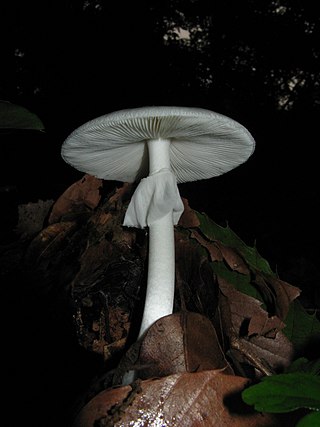
Amanita verna, commonly known as the fool's mushroom or the spring destroying angel, is a deadly poisonous basidiomycete fungus, one of many in the genus Amanita. Occurring in Europe in spring, A. verna associates with various deciduous and coniferous trees. The caps, stipes and gills are all white in colour.

Cerrena unicolor, commonly known as the mossy maze polypore, is a species of poroid fungus in the genus Cerrena. This saprobic fungus causes white rot.

Clitocybe nebularis or Lepista nebularis, commonly known as the clouded agaric, cloudy clitocybe, or cloud funnel, is an abundant gilled fungus which appears both in conifer-dominated forests and broad-leaved woodland in Europe and North America. Appearing in Britain from mid to late autumn, it is edible, but may cause gastrointestinal issues.

Cyptotrama asprata, commonly known as the golden-scruffy collybia or spiny woodknight is a saprobic species of mushroom in the family Physalacriaceae. Widely distributed in tropical regions of the world, it is characterized by the bright orange to yellow cap that in young specimens is covered with tufts of fibrils resembling small spikes. This fungus has had a varied taxonomical history, having been placed in fourteen genera before finally settling in Cyptotrama. This species is differentiated from several other similar members of genus Cyptotrama by variations in cap color, and spore size and shape.
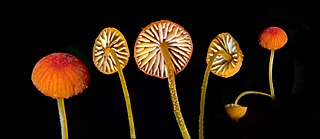
Mycena acicula, commonly known as the orange bonnet, or the coral spring Mycena, is a species of fungus in the family Mycenaceae. It is found in Asia, the Caribbean, North America and Europe. The fruit bodies, or mushrooms, of the fungus grow on dead twigs and other woody debris of forest floors, especially along streams and other wet places. They have small orange-red caps, up to 1 cm (0.4 in) in diameter, held by slender yellowish stems up to 6 cm (2.4 in) long. The gills are pale yellow with a whitish edge. Several other Mycena species look similar, but may be distinguished by differences in size and/or microscopic characteristics. M. acicula is considered inedible because of its small size.

Panellus stipticus, commonly known as the bitter oyster, the astringent panus, the luminescent panellus, or the stiptic fungus, is a species of fungus. It belongs in the family Mycenaceae, and the type species of the genus Panellus. A common and widely distributed species, it is found in Asia, Australia, Europe, and North America, where it grows in groups or dense overlapping clusters on the logs, stumps, and trunks of deciduous trees, especially beech, oak, and birch. During the development of the fruit bodies, the mushrooms start out as tiny white knobs, which, over a period of one to three months, develop into fan- or kidney-shaped caps that measure up to 3 cm (1.2 in) broad. The caps are orange-yellow to brownish, and attached to the decaying wood by short stubby stalks that are connected off-center or on the side of the caps. The fungus was given its current scientific name in 1879, but has been known by many names since French mycologist Jean Bulliard first described it as Agaricus stypticus in 1783. Molecular phylogenetic analysis revealed P. stipticus to have a close genetic relationship with members of the genus Mycena.

Hygrophorus eburneus, commonly known as the ivory waxy cap or the cowboy's handkerchief, is a species of edible mushroom in the waxgill family of fungi. It is widespread in Europe and North America, and has also been collected in northern Africa. The fruit bodies are medium-sized, pure white, and when wet are covered in a layer of slime thick enough to make the mushroom difficult to pick up. The gills are broadly attached to the stem or running down it; as the family name suggests, they feel waxy when rubbed between the fingers. Like all Hygrophorus species, the fungus is mycorrhizal—a symbiotic association whereby the underground fungal mycelia penetrate and exchange nutrients with tree roots. They are common in a variety of forest types, where they grow on the ground in thickets or grassy areas. Hygrophorus eburneus is the type species of the genus Hygrophorus. A number of biologically active chemicals have been purified from the fruit bodies of the fungus, including fatty acids with bactericidal and fungicidal activity.
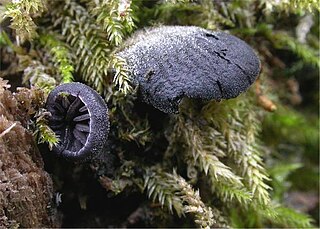
Resupinatus applicatus, commonly known as the smoked oysterling or the black jelly oyster, is a species of fungus in the family Tricholomataceae, and the type species of the genus Resupinatus. First described in 1786 as Agaricus applicatus by August Johann Georg Karl Batsch, it was transferred to Resupinatus by Samuel Frederick Gray in 1821.

Phyllotopsis nidulans, commonly known as the mock oyster or the orange oyster, is a species of fungus in the family Phyllotopsidaceae, and the type species of the genus Phyllotopsis. It is widely dispersed in temperate zones of the Northern Hemisphere, where it grows on decaying wood. The fungus fruit body consists of a fan-shaped, light orange fuzzy cap up to 8 cm (3 in) wide that grows singly or in overlapping clusters. On the cap underside are crowded orange gills. Mock oyster mushrooms have a strong, unpleasant odor, and are regarded as inedible though nonpoisonous.
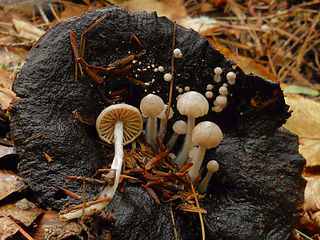
Asterophora parasitica, commonly known as the parasitic Asterophora or the Russula parasite, is a species of fungus that grows as a parasite on other mushrooms. The fruit bodies are small, with silky fibers on the surface of grayish caps and thick, widely spaced gills. Mushrooms fruit in clusters on the decaying remains of Lactarius and Russula species, particularly those in the Russula nigricans group. Found primarily in temperate zones of Europe and North America, the fungus is widespread but not common.

Gilled fungi with laterally-attached fruiting bodies are classified as pleurotoid. Pleurotoid fungi are typically wood-decay fungi and are found on dead and dying trees and coarse woody debris. The pleurotoid form is polyphyletic, having evolved a number of times within the Basidiomycota. Many species of pleurotoid fungi are commonly referred to as "oyster" mushrooms. Laterally-attached fungi with pores rather than gills are referred to as bracket fungi.

Protostropharia semiglobata, commonly known as the dung roundhead, the halfglobe mushroom, or the hemispherical stropharia, is an agaric fungus of the family Strophariaceae. A common and widespread species with a cosmopolitan distribution, the fungus produces mushrooms on the dung of various wild and domesticated herbivores. The mushrooms have hemispherical straw yellow to buff-tan caps measuring 1–4 cm (0.4–1.6 in), greyish gills that become dark brown in age, and a slender, smooth stem 3–12 cm (1.2–4.7 in) long with a fragile ring.

Hapalopilus rutilans is a species of polypore fungus in the family Polyporaceae. Officially described in 1821, it was transferred to its current genus Hapalopilus six decades later. It is commonly known as the tender nesting polypore, purple dye polypore, or the cinnamon bracket. This widely distributed species is found on five continents. It grows on the fallen or standing dead wood of deciduous trees, in which it fruits singly, in groups, fused, or in overlapping clusters. Fruit bodies are in the form of kidney-shaped to semicircular, cinnamon-orange-brown brackets. The underside of the fruit body features a yellowish to brownish pore surface with tiny angular pores, from which spores are released.

Mycena purpureofusca, commonly known as the purple edge bonnet, is a species of agaric fungus in the family Mycenaceae. First described by Charles Horton Peck in 1885, the species is found in Europe and North America, where it grows on the decaying wood and debris of conifers, including cones. Fruit bodies have conical to bell-shaped purple caps up to 2.5 cm (1 in) set atop slender stipes up to 10 cm (4 in) long. The mushroom is named for the characteristic dark greyish-purple color of its gill edges. In the field, M. purpureofusca mushrooms can usually be distinguished from similar species by characteristics such as the dark purple gill edges, the deep purple cap center, and its cartilagineous consistency. The fungus contains a laccase enzyme that has been investigated scientifically for its potential to detoxify recalcitrant industrial dyes used in textile dyeing and printing processes.

Lentinus strigosus is a species of fungus in the family Polyporaceae. It is edible when young, but becomes very tough with age.

Sarcomyxa serotina is a species of fungus in the family Sarcomyxaceae. Its recommended English name in the UK is olive oysterling. In North America it is known as late fall oyster or late oyster mushroom. Fruit bodies grow as greenish, overlapping fan- or oyster-shaped caps on the wood of both coniferous and deciduous trees. The gills on the underside are closely spaced, bright orange yellow, and have an adnate attachment to the stipe. It produces a yellow spore print; spores are smooth, amyloid, and measure 4–6 by 1–2 µm.
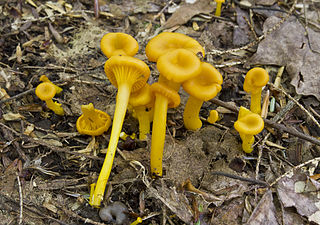
Gloioxanthomyces nitidus, commonly known as the shining waxcap, is a species of fungus in the family Hygrophoraceae.
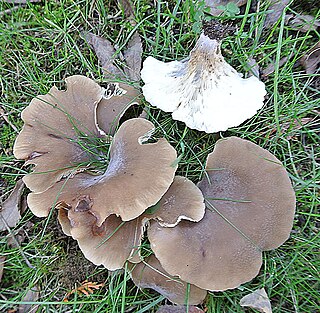
Hohenbuehelia petaloides, commonly known as the leaflike oyster or the shoehorn oyster mushroom, is a species of agaric fungus belonging to the family Pleurotaceae. The fruit bodies have pale to brown funnel-shaped caps with decurrent gills and are considered edible. The species has a cosmopolitan distribution and is found near the decaying wood it feeds on.
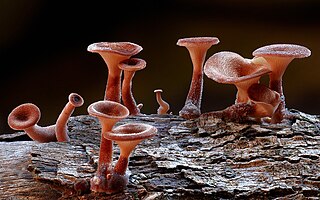
Panus fasciatus is a species of fungus in the family Polyporaceae in the genus Panus of the Basidiomycota. P. fasciatus has a fruiting body in the shape of a funnel with a velvety texture, hence the nickname "hairy trumpet." When it was identified by D. Pegler of Kew, he created a subgroup of the Lentinus fungi, called Panus based on their hyphal systems. For this reason, Panus fasciatus is sometimes referred to as Lentinus fasciatus. Panus fasciatus has been described with numerous other names which were combined by Pegler in 1965.




















